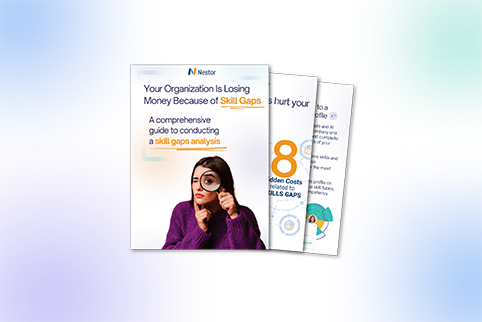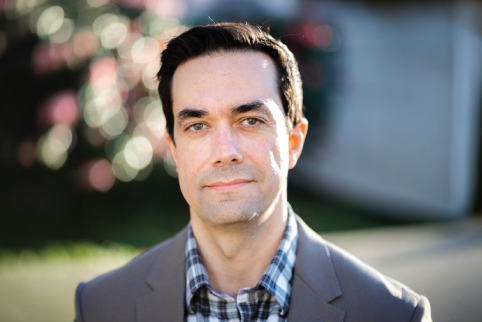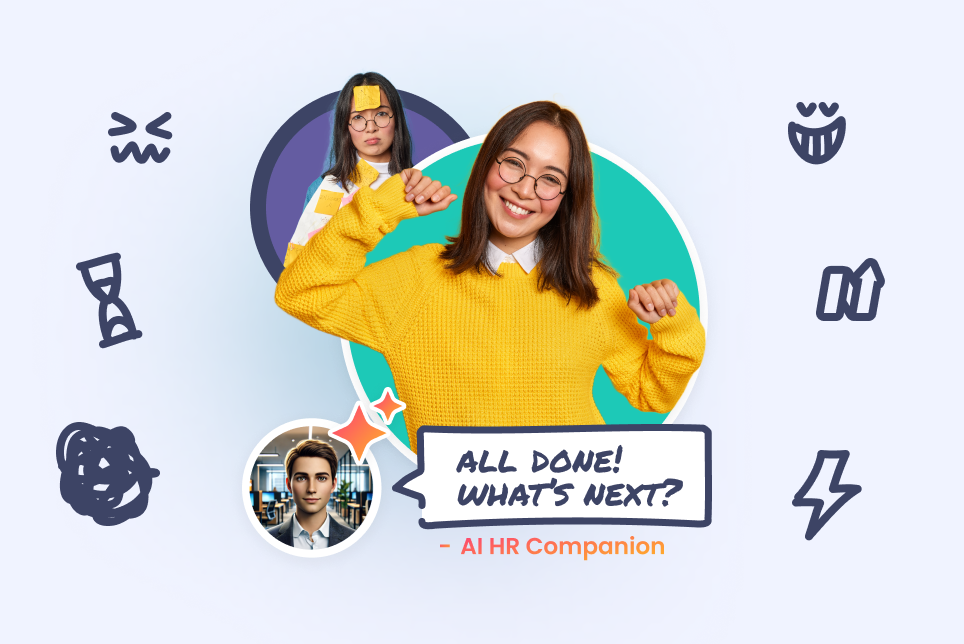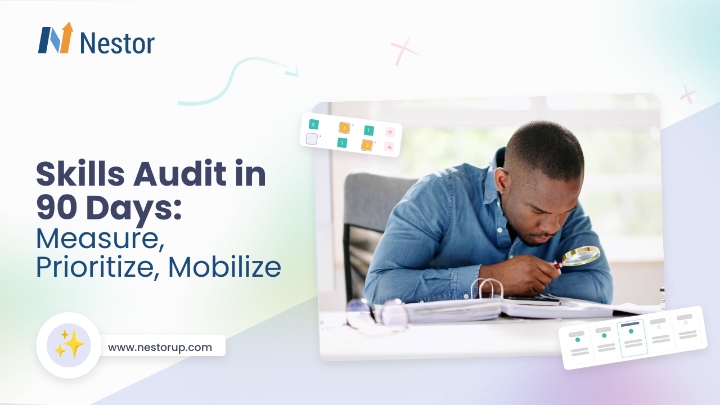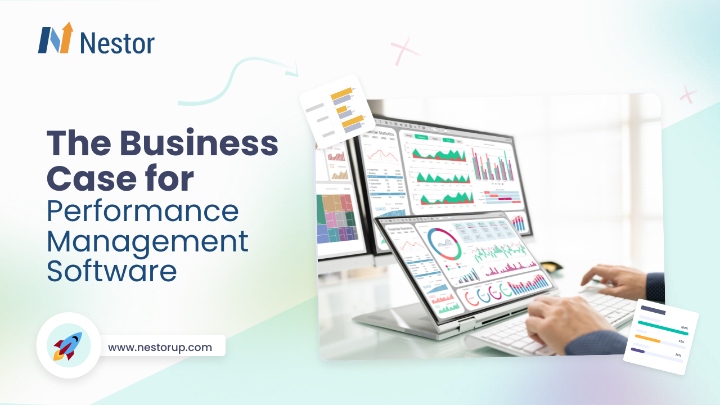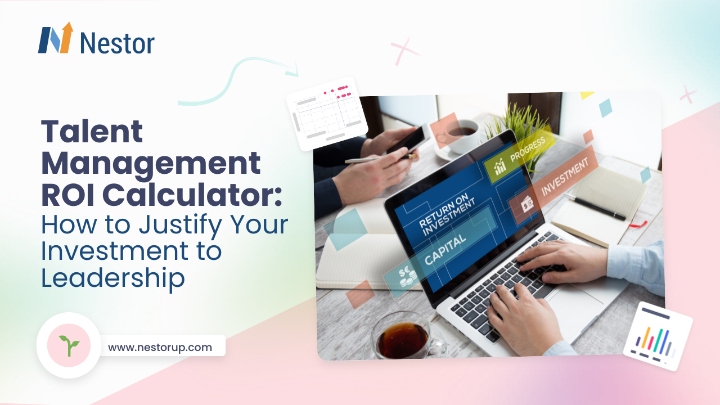Talent Intelligence for CHROs: Align HR with Business Strategy Using AI
19 min read

Contents
The role of the Chief Human Resources Officer has never been more visible, or more demanding. Employers expect 39% of core skills to change by 2030, making the CHRO role more about foresight than administration. Beyond running payroll or managing compliance, CHROs are also being asked to shape business strategy itself. And Talent Intelligence is becoming the framework that allows them to do it with evidence rather than intuition.
They’re expected to answer tough questions: Do we have the right skills to deliver next year’s growth targets? Are our teams ready to handle new technologies? How can HR investments show measurable business impact? And it’s not hypothetical pressure. 45% of CEOs say their companies won’t be viable beyond ten years if they don’t adapt.
This is where Talent Intelligence comes in. At its simplest, Talent Intelligence means gathering, analyzing, and applying data about skills and workforce capabilities to guide smarter decisions. It’s not just another HR metric. It’s the connective tissue between people strategy and company strategy.
Think of it like this: A CFO uses financial forecasts to guide capital allocation. A CHRO, equipped with Talent Intelligence, can do the same for people: forecasting skills demand, anticipating gaps, and steering workforce development toward business priorities. Without this lens, HR risks operating in the dark, making decisions that feel tactical rather than strategic.
And let’s be honest, the pressure is real. Skills are evolving faster than most companies can keep up. Emerging technologies, new market dynamics, and shifting employee expectations all collide to make workforce planning harder than ever. But with AI-driven Talent Intelligence, CHROs can move from guessing to knowing.
For leaders who want HR to sit confidently at the strategy table, Talent Intelligence is becoming the language that earns trust across the C-suite.
What is Talent Intelligence?
Talent Intelligence is one of those terms that can sound abstract until you see how it changes daily decisions. At its core, it’s the practice of gathering, interpreting, and applying data about workforce skills and potential to guide smarter choices. It gives HR leaders a living picture of what the company is capable of today and what it will need tomorrow.
That might sound simple, but the difference is profound. For years, HR has worked with lagging indicators: turnover reports, training completion rates, annual engagement surveys. They explain what happened but rarely give guidance on what’s coming.
Talent Intelligence flips the perspective. It’s less about reporting history and more about answering questions like: Are we ready to expand into that market? Do we have the right leadership pipeline? Which skill shortages could stall our strategy?
If finance has forecasting models and operations has process dashboards, Talent Intelligence is the CHRO’s equivalent. It doesn’t replace judgment, but it adds a level of evidence that has been missing in workforce conversations. Training activity is rising, 50% of employees took part in company training in 2024, up from 41% in 2023, but without context, that momentum risks being scattershot.
How Talent Intelligence Works in Practice
Rather than being a single system or tool, Talent Intelligence is a way of combining data and insight across multiple touchpoints. A few components stand out:
- Skills mapping Instead of relying on job titles or outdated resumes, Talent Intelligence builds a real-time inventory of capabilities. It captures not only the skills people were hired for but also the ones they’ve developed through projects, training, or even side initiatives. Think of it as a living skills “map” that evolves with the organization.
- Readiness tracking Having a skill doesn’t always mean an employee can apply it in a bigger role or a new environment. Talent Intelligence measures readiness by looking at indicators such as learning velocity, leadership experience, or adaptability. This helps identify who can step up, who needs support, and where succession risks exist.
- Predictive signals The real advantage comes from looking ahead. By analyzing trends in hiring, internal mobility, and external labor markets, Talent Intelligence can forecast where shortages are likely, which roles may need urgent attention, and where development investments will pay off most.
Why It Matters to CHROs
The role of the CHRO has changed. Boards and CEOs now expect HR leaders to answer the same forward-looking questions as other executives. Talent Intelligence gives them the language and evidence to do so.
Consider the difference in these two statements:
- “We’ve trained 500 employees this year.”
- “We’ve increased readiness in the skills needed for next year’s product launch by 35%.”
Both are true, but only the second resonates in a strategic discussion. That’s the power of Talent Intelligence. It ties people data directly to business outcomes.
There’s also a cultural element. Employees notice when their skills are tracked in ways that feel meaningful. When development conversations shift from generic performance scores to a clear view of where their skills fit into the company’s future, growth feels tangible. That sense of connection drives engagement in ways traditional HR metrics never could.
Talent Intelligence, then, isn’t just another dashboard. It’s a shift in perspective, away from HR as an administrative function and toward HR as the steward of the organization’s future capacity. For CHROs, it’s quickly becoming the difference between being heard in strategy discussions and being left to report after decisions are made.
How AI Transforms Talent Intelligence for CHROs
For a long time, HR data has felt static. You’d run a skills survey, clean up the spreadsheets, and by the time you finished, the reality had already shifted. Someone left, someone learned something new, the business decided to chase a different priority. AI changes that rhythm. It makes the workforce visible in real time, not just once a year.
The difference is subtle at first. You start by seeing skills in more detail, not just job titles or certificates. But the real power shows up when you can connect those skills to business questions.
Say the board asks if the company can support a new line of services. Instead of relying on manager opinions or dated records, you can answer with evidence: which teams have the knowledge, which don’t, and what it would take to close the gap.
That’s Talent Intelligence with AI. It gives HR leaders the ability to respond with clarity instead of estimates. And when done well, companies with strong learning cultures see 57% higher retention and 23% more internal mobility.
Another piece worth noting: readiness. Having a skill on paper doesn’t always mean someone can carry it into a bigger role. AI can pick up signals from performance, mobility, even how quickly someone learns, and turn that into a more reliable view of who might be ready next. It doesn’t remove judgment, but it grounds succession conversations in something more concrete.
And when you link all of this back to strategy, the tone of HR in the C-suite changes. You’re no longer asking for budget with vague outcomes. You’re showing exactly how learning investments connect to revenue, how succession planning lowers risk, how new hires accelerate innovation. That’s the shift AI makes possible: HR doesn’t just manage people, it manages the organization’s capacity to deliver.
Strategic Benefits of Talent Intelligence for CHROs
When CHROs use Talent Intelligence powered by AI, the conversation around HR shifts. Instead of being viewed as the function that reports on headcount and engagement, HR becomes the function that explains whether the business has the capacity to deliver on its goals. That repositioning carries real weight at the executive table.
Here are some of the most important benefits CHROs can expect when they lean into Talent Intelligence:
1. Greater Influence in the C-Suite
Every C-suite leader speaks in the language of evidence. CFOs forecast margins, COOs track throughput, and CIOs measure system resilience. With Talent Intelligence, CHROs finally bring their own version of forward-looking evidence.
- Instead of describing HR programs, they can present readiness forecasts for critical skills.
- Instead of discussing training completions, they can show how development initiatives shorten time-to-market or reduce risk in new ventures.
That shift in language makes HR part of strategy conversations rather than a reporting function. It also builds credibility. Leaders stop questioning whether HR has a “seat at the table” because HR is already shaping the discussion.
2. Faster and More Confident Decision-Making
Traditional talent reports lag behind business needs. By the time HR circulates its quarterly update, priorities may have already changed. Talent Intelligence accelerates the cycle: insights update continuously, giving leaders the ability to react quickly to new opportunities or disruptions.
- If the company acquires a smaller firm, Talent Intelligence helps assess integration capacity within weeks, not months.
- If a product launch is delayed, leaders can immediately see whether talent shortages are part of the problem and how to respond.
For CHROs, this agility means they’re no longer catching up to strategy but they’re helping shape it in real time. And that agility is essential when 47% of HR leaders report recruiting full-time roles is harder than it was a year ago.
3. Workforce Agility and Capacity
Markets shift quickly, and companies that can redeploy talent toward new priorities gain a real advantage. Talent Intelligence helps CHROs measure and guide this agility.
- Which employees can move laterally into critical roles?
- Where are clusters of skills that could be redirected toward growth areas?
- Which gaps pose a block to execution?
The answers to these questions go beyond HR by shaping whether the organization can deliver on its commitments to investors, customers, and employees.
4. Stronger Business Case for HR Investments
One of the perennial challenges for HR leaders is proving the ROI of their programs. Without clear links to outcomes, development initiatives or new tools often get labeled as “cost centers.” Talent Intelligence changes that narrative.
- Upskilling can be tied directly to revenue growth or product timelines.
- Succession planning can be framed as a risk management strategy, reducing exposure to leadership gaps.
- Hiring decisions can be evaluated based on how they accelerate strategic priorities.
The result: HR budgets are no longer defended with soft arguments about engagement. They’re justified in the same financial terms as any other business investment.
5. Cultural Impact and Employee Engagement
The strategic value is clear, but there’s also a human benefit. When employees see their skills recognized and tied to company priorities, development feels meaningful. It’s no longer “another training course” but a progress toward opportunities that matter, both to the business and to the individual.
This builds trust. Employees understand that their growth is not an afterthought but central to the organization’s strategy. That sense of relevance fuels engagement, retention, and discretionary effort at a time when talent competition is fierce.
Bringing It All Together
For CHROs, these benefits converge into something larger: sustained influence. Talent Intelligence redefines HR’s role as the steward of business capacity. It positions the CHRO as the executive who can connect strategy with the people who make it possible.
Once the business experiences HR in this role, the shift is difficult to reverse. Talent Intelligence becomes not just an HR initiative, but a critical part of how the company plans, grows, and competes.
Nestor: Enabling Talent Intelligence in Action
Concepts like Talent Intelligence are powerful, but they need a practical way to come to life. That’s where platforms such as Nestor make the difference. Nestor is designed to help organizations see their workforce clearly (skills, readiness, and growth potential) and connect that visibility directly to business priorities.
The value extends beyond HR. Yes, CHROs use Nestor to shape strategy conversations, but business leaders, team managers, and even employees benefit from having a single, transparent view of what the workforce can do and where it needs to grow.
Here’s how Nestor supports this shift:
1. A Unified Skills Framework Across the Organization
Most companies struggle with scattered talent data. Job descriptions sit in one system, learning records in another, and manager notes in yet another. Nestor consolidates these signals into a consistent skills framework, creating a shared “language of capability” that everyone, from HR to line managers, can use.
For executives, this means they can finally connect workforce capability to strategy. For employees, it means their skills aren’t hidden or underappreciated. They’re visible and valued.
2. Real-Time Visibility Into Readiness
Nestor doesn’t just log who has what skills. It shows whether teams and individuals are ready for future demands. This readiness lens helps leaders answer practical questions:
- Do we have enough leaders prepared to step up if we expand into new markets?
- Which teams need targeted support before they can handle a major transformation project?
- Are we relying too heavily on a small group of specialists for critical skills?
The answers guide business planning. A COO can use these insights to anticipate operational risks. A CFO can see whether workforce capacity matches projected growth.
3. AI-Powered Recommendations That Guide Action
Data without context is overwhelming. Nestor applies AI to recommend what actions will have the greatest impact. That might mean highlighting hidden internal talent before approving new hires, suggesting targeted learning paths to close a skills gap, or flagging employees who could transition into emerging roles.
This turns Talent Intelligence into more than a report. It becomes a decision-making engine that supports managers, executives, and employees in shaping the workforce together.
4. Direct Link Between People Decisions and Business Outcomes
The most powerful contribution of Nestor is that it connects workforce data to business goals in a way that resonates beyond HR. Whether the objective is growth, innovation, or risk reduction, leaders can see exactly how people initiatives contribute.
- Executives: clarity on whether the company has the skills to execute strategy.
- HR teams: evidence to guide where to invest in development or hiring.
- Employees: a transparent view of how their growth aligns with the company’s direction.
The result is a shared understanding across the organization that people decisions aren’t separate from business strategy. They are the strategy.
Why It Matters
When a company uses Nestor, HR leaders gain credibility, executives gain clarity, and employees gain a sense of connection between their skills and the future of the business. It’s not a tool for HR alone. It’s a platform that helps the entire organization make smarter choices about growth, risk, and capacity.
Practical Steps for CHROs to Get Started with Talent Intelligence
Building Talent Intelligence doesn’t require overhauling every HR process on day one. The most successful organizations start small, prove value quickly, and expand step by step. The key is to treat it not as a side project, but as a new way of connecting people and business.
Here’s a roadmap leaders can use:
1. Audit What You Already Have
Most companies underestimate the amount of talent data already sitting in their systems. HRIS platforms, learning management systems, performance reviews, and even manager spreadsheets all hold valuable clues about skills and potential. The first step is to gather what’s already available and evaluate its quality.
- Are skills captured consistently or only in job descriptions?
- Which roles or teams are underrepresented in the data?
- How current is the information?
Even if the picture isn’t complete, this baseline helps identify where Talent Intelligence can deliver quick wins.
2. Tie Efforts to Business Priorities
Talent Intelligence works best when it’s connected to the company’s most pressing goals. If recruiting is part of the challenge, remember, 76% of employers said new hires lacked needed skills last year, Talent Intelligence can show whether you should train internally before chasing scarce external talent. Before rolling out any platform, clarify the business questions that matter most.
- Expanding into new markets? Then the focus should be on language capabilities, cultural awareness, and global operations skills.
- Driving digital transformation? Prioritize readiness in areas like data, AI, and technology adoption.
- Worried about succession? Put leadership development and pipeline strength at the center of the strategy.
Anchoring to strategy keeps Talent Intelligence relevant and ensures HR insights resonate with the rest of the C-suite.
3. Select the Right Platform Partner
Collecting data is one thing; turning it into insight is another. Tools like Nestor provide a central framework that maps skills, tracks readiness, and uses AI to recommend actions. The platform should serve multiple audiences:
- Executives, who need visibility into whether strategy is achievable with current talent.
- HR leaders, who require evidence to shape programs and budgets.
- Managers, who want to understand team strengths and gaps.
- Employees, who should see how their skills fit into the bigger picture.
A good platform balances sophistication with usability. If it feels like another system no one wants to log into, adoption will stall.
4. Start with a Pilot, Not the Whole Organization
Trying to build Talent Intelligence for an entire company at once can overwhelm even the strongest teams. A better approach is to pilot it with a single business unit or a strategic initiative.
For example:
- Track readiness for a new product launch.
- Map skills within the technology division.
- Identify succession gaps in senior leadership.
Early wins build credibility and create a model for scaling across the organization.
5. Embed Insights Into Daily Workflows
Talent Intelligence isn’t valuable if it sits in a dashboard. To make it stick, integrate insights into the processes leaders already use:
- Hiring decisions guided by skill maps, not gut feel.
- Learning investments directed by future business needs, not employee popularity polls.
- Succession planning based on readiness signals, not just manager nominations.
When insights are part of daily choices, Talent Intelligence becomes a habit, not a project.
6. Translate Outcomes Into Business Language
Finally, success depends on how results are communicated. Engagement scores, completion rates, or HR metrics won’t resonate with most executives. Reframe outcomes in terms of business capacity.
- “We’ve reduced the risk of a leadership gap in key roles by 40%.”
- “We’ve built 70% of the skills required for the next digital initiative internally, reducing hiring costs.”
- “We can accelerate the product launch timeline by six months thanks to targeted development.”
This kind of framing ensures HR insights carry the same weight as financial or operational metrics.
A Gradual Shift That Compounds Over Time
The point isn’t perfection on day one. It’s progress that proves the concept. Each cycle of planning, review, or investment strengthens the model. Over time, Talent Intelligence moves from being “an HR experiment” to being part of how the company runs itself.
The Future of CHRO Leadership with Talent Intelligence
Business leaders are measured by their ability to prepare for what’s next. CFOs model cash flow. COOs track operational capacity. CTOs anticipate technology shifts. For too long, HR has lacked an equivalent tool, something forward-looking, grounded in evidence, and connected directly to business priorities. Talent Intelligence changes that.
By combining AI with workforce data, Talent Intelligence gives leaders a living picture of their organization’s capacity: what skills exist, which ones are emerging, where readiness gaps pose a risk, and how people decisions tie directly to strategy. It transforms conversations about HR from administrative updates into strategic discussions.
But the benefits don’t stop with HR. Executives across functions gain a clearer sense of whether strategy is executable. Managers gain confidence in developing their teams. Employees gain trust that their careers are part of the company’s future.
Platforms like Nestor make this possible by bringing all of these pieces together. With a unified skills framework, real-time readiness insights, and AI-driven recommendations, leaders can finally see talent in the same way they see financial or operational capacity: as something measurable, trackable, and actionable.
The future of leadership, whether in HR, finance, operations, or technology, will be measured by how well people capacity matches business ambition. Talent Intelligence is the bridge. And the companies that build it now won’t just react faster to change; they’ll define the pace of change for their industries.
Frequently Asked Questions About Talent Intelligence
1. What is Talent Intelligence in HR?
Talent Intelligence is the use of AI and data to understand workforce skills, readiness, and potential. It goes beyond traditional HR analytics by predicting skill gaps, tracking talent pipelines, and linking people decisions to business strategy.
2. Why is Talent Intelligence important for companies?
Talent Intelligence is important because it shows whether an organization has the skills and capacity to deliver on its business goals. It helps leaders reduce risks, make faster decisions, and invest in the right areas of hiring and development.
3. How does Talent Intelligence use AI?
AI in Talent Intelligence collects and analyzes workforce data in real time. It maps skills, tracks employee readiness, and recommends actions like targeted learning or internal mobility. Without AI, Talent Intelligence is slower and less accurate.
4. What is the difference between Talent Intelligence and people analytics?
People analytics looks backward, measuring past HR activity such as turnover, time-to-hire, or engagement scores. Talent Intelligence looks forward, focusing on what skills are available now, what gaps exist, and how ready employees are for future priorities.
5. How does Talent Intelligence help employees, not just HR?
For employees, Talent Intelligence makes skills and growth visible. It helps them see how their capabilities connect to company strategy, which creates clearer career paths and more meaningful development opportunities.
6. Can small and mid-sized businesses use Talent Intelligence?
Yes. Talent Intelligence is not only for large enterprises. Smaller companies use it to plan growth, reduce hiring mistakes, and build strong leadership pipelines early. Platforms like Nestor make it practical to start small and expand.
7. How can a company start building Talent Intelligence?
The easiest way to start is by focusing on one area such as a critical skill, a key business unit, or a succession plan. From there, use a platform like Nestor to consolidate data, create a skills map, and connect workforce insights directly to business outcomes.



